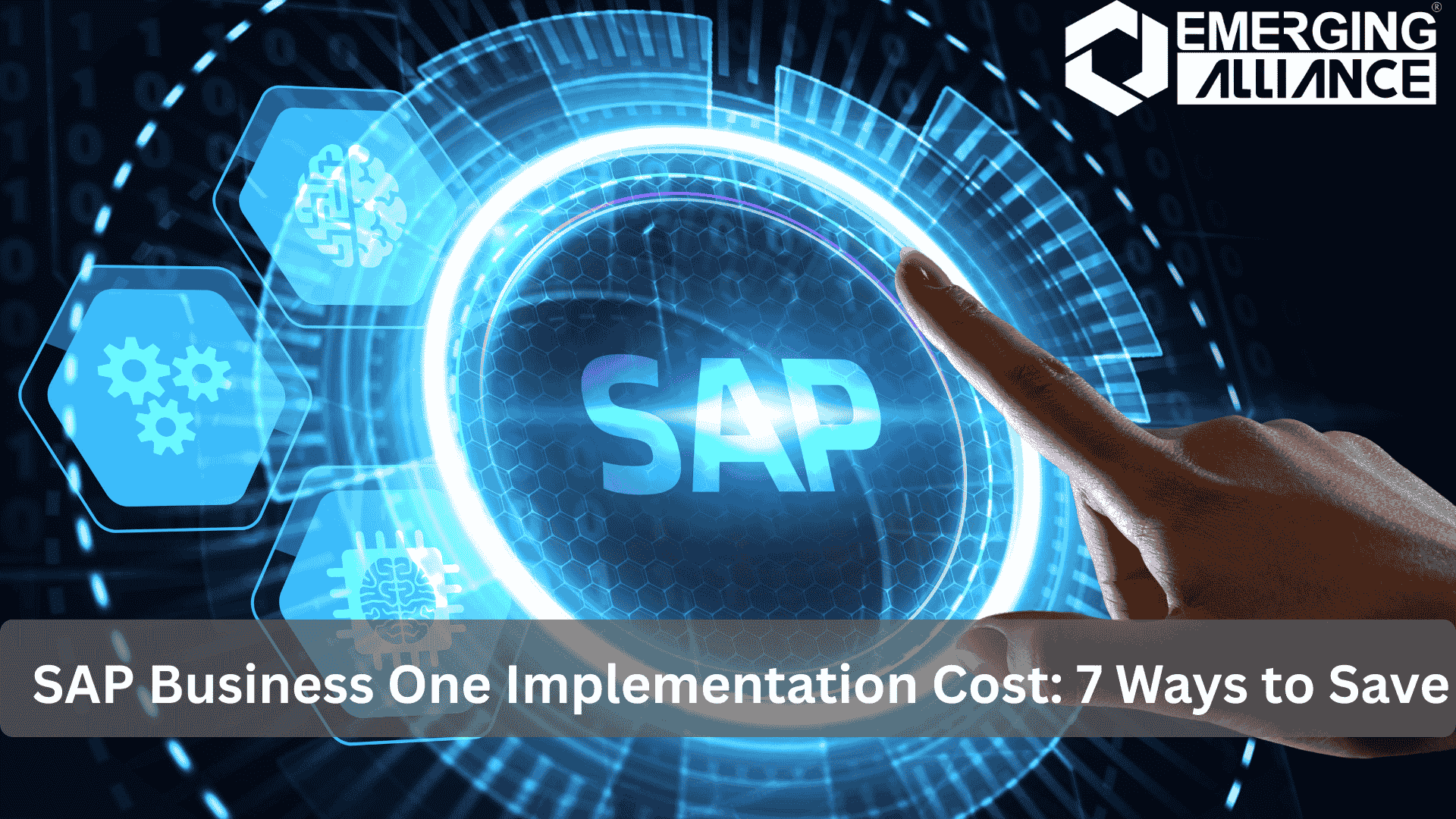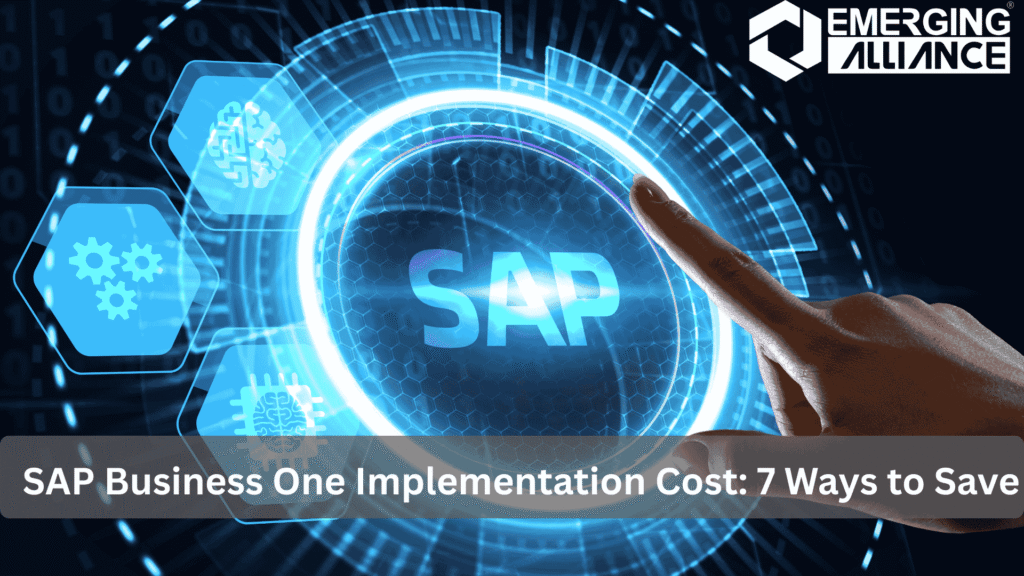
SAP Business One Implementation Pricing: 7 Ways to Save

Top 7 Ways to Reduce Your SAP Business One Implementation Pricing
Implementing SAP Business One is one of the most strategic decisions a growing business can make. It helps automate operations, increase efficiency, and improve visibility across departments. However, one of the biggest concerns businesses face is managing SAP Business One pricing and understanding the elements that contribute to the total SAP Business One implementation cost.
Many organizations fear ERP systems because they assume they are expensive or complicated. But SAP Business One is built for small and mid-sized businesses — meaning the system is scalable, affordable, and adaptable to various business needs. The key to keeping your SAP Business One pricing under control lies in planning smartly and avoiding unnecessary expenses.
This guide explains the top 7 proven ways to reduce SAP B1 implementation costs, helping you achieve a smoother implementation and higher ROI without overspending.
Top Factors Influencing Your SAP Business One Implementation Costs & Pricing
1. Choose the Right Licensing Model to Reduce SAP B1 Implementation Costs
Licensing plays one of the biggest roles in determining your SAP Business One pricing, and choosing the right model from the start helps avoid excessive upfront investment. Understanding SAP Business One implementation costs helps businesses plan smarter and avoid budget surprises.
SAP Business One offers two primary licensing models:
Perpetual Licensing
This is a one-time purchase with an annual maintenance fee.
- Ideal for long-term use
- Suitable for organizations with in-house IT teams
- Higher upfront cost but lower ownership cost over time
Subscription Licensing (Cloud-Based)
This is a pay-as-you-go model with predictable monthly pricing.
- Lower startup cost
- No hardware or server investment
- Maintenance and upgrades included
Pro Tip:
Analyze your user roles carefully. Many businesses reduce total SAP B1 pricing by assigning Limited User licenses to employees who don’t require full access. Mixing license types effectively can bring down costs by up to 30%.%.
2. Create a Clear ERP Roadmap to Control SAP Business One Implementation Costs
One of the most common reasons businesses exceed their SAP B1 implementation pricing is due to vague planning or changing requirements mid-way. A clear implementation roadmap not only reduces cost but also shortens the go-live timeline. Many SMEs reduce their overall SAP Business One implementation costs by selecting only essential modules during the first phase.
Planning Steps That Lower SAP B1 Deployment Costs
- Well-defined project scope
- Clear objectives for each department
- Identified modules required for Phase 1
- Proper documentation of business processes
- Realistic go-live dates and milestones
By mapping your processes early and establishing expectations, your SAP partner can provide a more accurate estimate for your SAP Business One pricing, preventing costly surprises.es.
3. How a Certified SAP Partner Helps Reduce SAP B1 Implementation Pricing
Working with an experienced and certified SAP partner dramatically reduces both the time and cost it takes to implement SAP Business One. Many pricing escalations occur because companies select inexperienced vendors who mismanage the project. If not planned properly, SAP Business One implementation costs can rise due to unnecessary customization and unclear project scope.
Partner Expertise That Minimizes SAP B1 Implementation Costs
- Accurate pricing forecasts
- Faster configuration and setup
- Proven templates and industry-specific processes
- Reduced customization requirement
- Smooth data migration
- Minimised operational downtime
At Emerging Alliance, certified consultants ensure optimized usage of standard SAP B1 capabilities, helping businesses reduce unnecessary expenses while maximizing system performance.
Choosing the right partner is one of the most effective ways to bring down your SAP Business One implementation pricing. and affordability.
4.Use Standard SAP Business One Features to Cut Overall Implementation Costs
One of the biggest mistakes businesses make is requesting customizations early, which significantly increases the SAP Business One implementation cost. Working with the right partner ensures your SAP Business One implementation costs stay predictable and well-controlled.
Reduce SAP B1 Customization Costs with Built-In Functionality
SAP Business One already includes robust built-in modules for:
- Finance & Accounting
- Inventory & Warehouse Management
- Sales & CRM
- Purchasing & Procurement
- Production & MRP
- Reporting & Analytics
Many companies realize later that standard features already meet 70–80% of their needs.
Cost-saving strategy:
- Use standard functionality whenever possible
- Configure before customizing
- Introduce add-ons only when required
- Delay custom development until post go-live
Cost Insight:
Businesses that begin with standard modules save 20–40% of total SAP Business One implementation pricing in their first year.
Start simple. Scale later.
5. Choosing Cloud or On-Premise Deployment to Manage SAP Business One Pricing
Your deployment choice directly impacts your long-term SAP Business One pricing.
How Deployment Type Influences Total SAP B1 Implementation Cost
- Low upfront cost
- No server investment
- Automatic upgrades
- Faster setup
- Predictable monthly pricing
Cloud is ideal for small and mid-sized businesses looking for a budget-friendly, low-maintenance ERP setup.
On-Premise Deployment (Perpetual License)
- Higher upfront cost
- Lower long-term ownership cost
- Full control over server and data
- Flexible customization
On-Premise suits businesses with strong internal IT teams and long-term plans.
Pricing Tip:
If you are new to ERP or want to minimize initial spending, choose Cloud. Once your business grows, you can move to On-Premise if required.
Choosing the right deployment can help significantly reduce your SAP Business One implementation pricing.nfident.
6. Reduce SAP Business One Implementation Expenses with Early User Training
Training might seem like an additional expense, but it actually prevents higher support costs later. Without proper training, employees make costly mistakes that require consultant intervention — directly increasing your long-term SAP Business One pricing.
Training Benefits That Improve SAP B1 Cost Efficiency
- Fewer data entry mistakes
- Improved process speed
- Better user adoption
- Reduced helpdesk and support dependency
- Faster return on investment
Choose a partner who offers structured training sessions, detailed user manuals, and post-go-live support.
Well-trained employees reduce the total SAP B1 pricing by minimizing inefficiencies and avoiding system misuse.
7. Post-Go-Live Optimization for Long-Term SAP Business One Cost Savings
Training and post-go-live support also play a major role in minimizing long-term SAP Business One implementation costs.
Your SAP Business One implementation does not end at go-live. Continuous optimization ensures your system stays efficient and cost-effective.
Maintenance Strategies That Lower Future SAP B1 Costs
- Review system performance regularly
- Automate repetitive tasks
- Remove outdated customizations
- Add modules only when necessary
- Use analytics to track resource usage and efficiency
- Conduct periodic audits with your SAP partner
Pro Tip:
Optimizing your SAP B1 setup can reduce your annual support and maintenance expenses by up to 25%.
A well-optimized system lowers your SAP Business One pricing long after implementation.
Continuous improvement can reduce maintenance and upgrade costs by up to 25% annually.
Avoid These Common Mistakes That Increase SAP Business One Pricing
To keep your implementation cost controlled, avoid these frequent mistakes:
- Requesting customizations before exploring standard features
- Failing to clean up or prepare data before migration
- Adding modules you don’t need initially
- Underestimating training requirements
- Choosing inexperienced implementation partners
- Expanding the scope without updated pricing approvals
Understanding these pitfalls helps you prevent unexpected increases in your SAP Business One pricing.
Final Thoughts: Smarter Planning = Lower SAP Business One Pricing
Reducing SAP Business One implementation costs isn’t about cutting features — it’s about making smarter decisions. With the right licensing model, deployment choice, planning strategy, and partner expertise, you can enjoy a full-featured SAP B1 system while keeping pricing manageable.
By controlling your SAP Business One pricing, you achieve:
✔ Faster go-live
✔ Lower implementation cost
✔ Higher efficiency
✔ Better ROI
✔ Long-term scalability
For expert guidance and transparent pricing, partner with Emerging Alliance — your trusted SAP Business One implementation experts.
Frequently Asked Questions About SAP Business One Pricing
1. What factors influence the total SAP Business One implementation cost?
Several elements affect the overall investment—number of users, required modules, deployment model (cloud or on-premise), customization needs, data migration effort, and third-party integrations. Each of these directly impacts your SAP B1 project budget and overall pricing structure.
2. Is SAP Business One expensive for small and mid-sized businesses?
Not necessarily. SAP B1 is designed for SMEs with flexible plans, user-based billing, and modular pricing. The system can be scaled based on your needs, making the SAP B1 cost model affordable compared to many enterprise-grade ERPs.
3. How can businesses lower their SAP B1 deployment expenses?
You can reduce spending by choosing Essential modules first, avoiding unnecessary add-ons, using phased rollouts, and partnering with an experienced implementation provider. These strategies help reduce both operational effort and initial SAP Business One investment.
4. What is the pricing difference between cloud and on-premise SAP B1?
Cloud typically operates on subscription-based yearly fees, while on-premise requires an upfront server and infrastructure investment. Your choice affects long-term SAP B1 ownership cost, maintenance charges, and upgrade expenses.
5. Are there hidden costs involved in SAP B1 implementation?
Extras like custom reports, advanced integrations, additional training, and user expansion can add to the overall SAP Business One pricing. Working with transparent partners ensures you understand every cost component before signing off.
6. How long does it take to implement SAP Business One, and does duration impact cost?
A standard implementation takes 6–12 weeks. Longer timelines increase consulting hours, testing cycles, and training sessions, affecting your SAP B1 deployment budget. Faster, structured implementations typically lower costs.
7. Can SAP Business One costs be optimized after go-live?
Absolutely. You can optimize by reviewing user roles, removing unused modules, automating manual processes, and leveraging built-in analytics. This reduces your long-term SAP B1 system expenses and boosts ROI.
8. Do customization requirements increase SAP B1 expenses?
Yes. Heavy customization demands more development, testing, and integration effort. Sticking to standard features whenever possible helps control your SAP Business One customization cost.
9. Are training and support included in the SAP B1 pricing package?
Most partners offer training and basic support in their packages, but advanced support tiers or additional user training may cost extra. These influence your complete SAP Business One cost over time.
10. How can I estimate the total cost for my SAP Business One project?
Start by identifying your user count, necessary modules, business processes, deployment choice, and customization level. A certified partner can prepare a detailed estimate outlining your SAP B1 implementation pricing with clarity.







